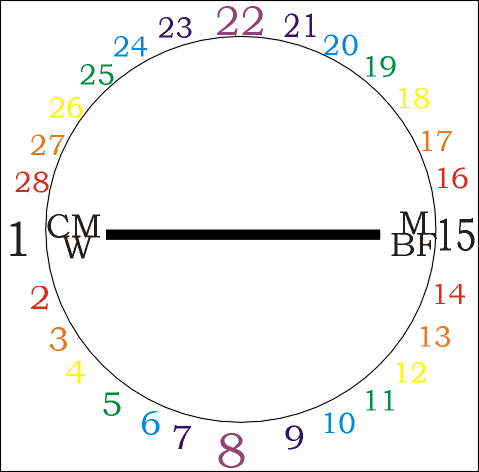The Wheel
The Wheel is in most respects the most natural form for the System’s expression, mainly because it is a more accustomed expression of cyclical phenomena and shows each stage as distinct though obviously linked to the whole, and it enables certain visualisations far more readily than the cones which can appear to be far more arbitrary.
The Faculties on the Wheel
On the Wheel it is evident that the two pairs of Opposites, Will: Mask and Creative Mind: Body of Fate, are always found across the diameter of the circle, and consequently in perpetual and reciprocal contrast, so that they are always of the opposite Tincture to the other. Similarly the two pairs of Discords, Will: Creative Mind and Mask: Body of Fate, are always reflected across the axis of Phase 1–Phase 15, so that they are always of the same Tincture as the other but in the opposite quarter. Yeats summarises the relationship when considering ‘True and False Creative Mind’: ‘Again two mirrors face one another’, since the Phase of Will and the Phase of Creative Mind ‘are alike in Tincture but different in direction’ (AV A 23). The figure of the Wheel also emphasises the way in which each Faculty proceeds around the circle in a single arc, and that the numbering is to some extent arbitrary, since it gives dominance to the development of the Will over the corresponding developments of the other Faculties.
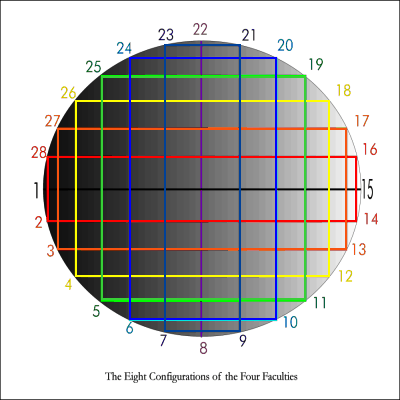 | Within the Wheel the positions of the Faculties therefore always form a rectangle, with the pairs of Opposites as diagonals, which clarifies the configurations and draws attention to the fact that there are only eight distinct combinations of the Phases, though the Faculties’ positions at the respective corners change. If any one of the Faculties is at Phase 4, then the other three must be at Phases 12, 18, and 26; if at Phase 6, Phases 10, 20 and 24. The relationships between the Faculties are also reciprocal. Those who are described as being at Phase 6, for instance, because their Will corresponds that Phase, draw their Mask from Phase 20, while those at Phase 20 derive their Mask from Phase 6; those of Phase 6 derive their Creative Mind from Phase 24, and again those of Phase 24 take their Creative Mind from Phase 6; and the same applies to the Body of Fate at Phase 10. The four quarters of the Wheel are always related to each other in the same way, and each person draws one of the Faculties from each quarter (apart from the four crucial phases of balance and crisis, which fall upon the boundaries between the quarters). |
| Click on any of the Phases in the diagram to the right to show a window with the attributes of the Phase: the character of each of the Faculties when the Will is at that Phase, its position on the Wheel, and the attributes of the Phase which affect the Faculties of the other Phases in the group.
If this map is not working for you click here for an alternative diagram. |
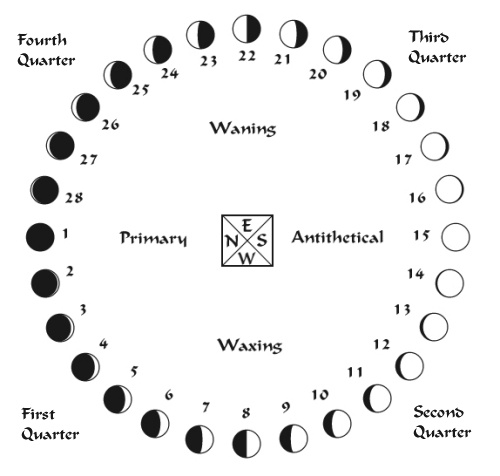
|
The Faculties are always disposed in the same relative Phases: the Phase of Will that diametrically opposite, Mask that reflected across the axis of the New Moon-Full Moon, Creative Mind and that reflected across the axis of the Phases of Crisis (8-22), Body of Fate. These Phases form a rectangle, except for the Cardinal Phases (1, 8, 15 and 22), and the four Phases are mutually linked, with reciprocal relationships between the Faculties of each of the group.
Certain groups have particular aspects in common. Two are particularly notable: the Phases of the four Wisdoms-4, 12, 18 and 26 and those of the four Perfections-3, 13, 17 and 27 (see AV B 100). The latter group is augmented by a penumbra around Phases 3 and 17, so that the two Phases on either side are also included.
| Group | 1-15 | 2-14-16-28 | 3-13-17-27 | 4-12-18-26 | 5-11-19-25 | 6-10-20-24 | 7-9-21-23 | 8-22 |
|---|---|---|---|---|---|---|---|---|
| First Quarter | ||||||||
| Second Quarter | ||||||||
| Third Quarter | ||||||||
| Fourth Quarter |
Since, in effect, each Faculty’s position is predetermined by the position of any single one, some have found Yeats’s insistence upon the attribution of the Faculties to the Phase from which they derive, rather than to that which they affect, superfluous and adding unnecessarily to the complexity of an already confusing system. There are several reasons why Yeats kept the distinction, including a desire for accuracy and an awareness that in other areas the distinction is necessary (see the True and False Faculties). Most importantly, however, the constructs of A Vision must show the importance of balance and the inescapability of the conflict, by presenting it as inherent in every form of human incarnation. Primary and antithetical are always balanced within each psyche: the two basically primary Faculties are balanced by the two antithetical Faculties these four Faculties are always equally distributed in primary and antithetical Phases on the wheel, and the predominance of either Tincture in one Faculty is offset by a complementary dominance in its opposite. This inherent conflict forms a cross and crucifies the individual upon the Wheel: ‘Life is an endeavour, made vain by the four sails of its mill, to come to a double contemplation, that of the chosen Image, that of the fated Image’ (AV B 94). Though there is always therefore balance between the Tinctures, there is never rest, for the equilibrium never reaches stasis.
In other areas, however, Yeats does vary the form and uses arrangements where Will and Creative Mind (and Mask and Body of Fate) move alongside one another but on different wheels. See Solar and Lunar Wheels, below.
The Wheel of the Principles
A fuller consideration of this topic is given in the page on the Principles, but the following summary may be of help here.
| The Principles move within their own gyres: the Spirit moves within the Celestial Body, represented by a double cone with the appearance of a lozenge or diamond; Passionate Body and Husk move together in opposition to each other, and their gyres are represented by a double cone with appearance of a triangular figure-of-eight or hour-glass. In terms of incarnate man, these two sets of gyres can also be seen as moving within the Wheel of the Phases: the diamond (Spirit and Celestial Body) moving slowly in a clockwise direction, at the pace of a Phase for each life-period, with the hour-glass (Passionate Body and Husk) moving in an anti-clockwise direction. | 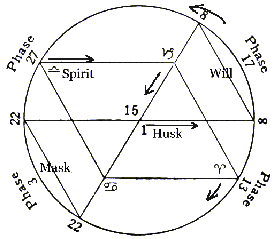 AV B 199 |
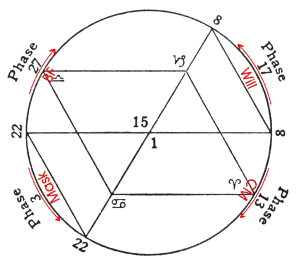 | The points where the Principles’ gyres contact the Wheel of the Faculties are the positions of the Four Faculties for that incarnation: ‘These cones are drawn across the centre of the wheel from Faculty to Faculty, two with bases joined between Creative Mind and Body of Fate, and two with apexes joined between Will and Mask’ (AV B 198). The figure therefore gives a geometrical representation of the way in which the Prinicples underlie the Faculties. The diamond of Celestial Body is actually a diagrammatic representation of a sphere, so is in contact with the Wheel throughout the cycle, but it is specifically activated at the point when Spirit passes through Libra, the point of birth, indicating the soul’s acceptance of its fated circumstances, Body of Fate. Husk (Will) and Passionate Body (Mask) reach their respective points of contact during maturity in the paradigmatic life, while Spirit contacts the point of Creative Mind when it reaches Aries, death. At death, consciousness passes from the Husk/Will to the Spirit, and the Faculties die or vanish (viz AV B 227). In terms of the Principles, since Spirit is the vital and continuing factor, the key movement is the clockwise progression of the diamond-gyre around the circle, marking the position of Creative Mind. |
| The diagram to the right summarises these various elements, and also tries to indicate that the movement is actually figured within cones rather than triangles. The inner circle represents the Zodiac of the Celestial Body and is identical with the diamond. The gyre of Spirit completes a single movement within the diamond or circle between birth and birth (or death and death), while the diamond/circle itself moves with respect to the outer circle by a single Phase. In Yeats’s own comparison, ‘Diamond and hour-glass revolve on one another like the sails of a windmill’ (AV B 199), which recalls the comment about the Faculties quoted above, that ‘Life is an endeavour, made vain by the four sails of its mill, to come to a double contemplation, that of the chosen Image, that of the fated Image’ (AV B 94). | 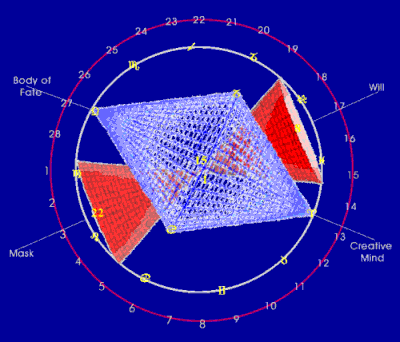 |
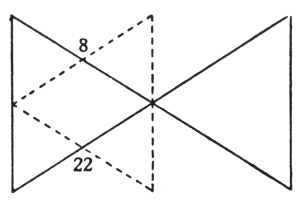 AV B 201 | The movement of the diamond around the whole circle of the twenty-eight incarnations marks one Cycle, but each life-period (birth to birth) and each incarnate portion of life also represents a single completed circle too. The cycle of the life-period is marked by the circuit of Spirit through the diamond and also of Husk and Passionate Body through the hour-glass, although for part of this cycle they are not apparent (Husk disappears shortly after it passes its Phase 15, and Passionate Body at some stage after it passes Phase 1; see Stages of the After-life). The incarnate portion of life is therefore represented by the movement of Husk from Phase 1 to Phase 15, and while Husk completes this half-circle, the Faculties complete a whole circle: ‘When Husk has reached Phase 8 they are at Phase 15; when Husk has reached its Phase 15 they are at Phase 1’ (AV B 201). Therefore one complete circle of the Faculties is equivalent to half a circle of the Principles and half of a Phase of the Cycle of incarnations (which Yeats confusingly refers to as ‘Will on circumference’). For a tabular summary, see the cycle of life in the page on the Principles. |
The essay "The Is and the Ought, the Knower and the Known: An Analysis of the Four Faculties in Yeats's System," by Rory Ryan in the collection W. B. Yeats's "A Vision": Explications and Contexts, edited by Neil Mann, Matthew Gibson, and Claire Nally (Clemson University, 2012), explores further aspects of the Wheel in A Vision.
This title is available for free download here or here from Clemson University Press (click here if seems the link may have changed). It is also accessible online via Liverpool Scholarhip Online and University Press Scholarship Online (simplest to search on "Yeats" and "Vision"; direct link functional April 2016), though this is by subscription or through a library.
